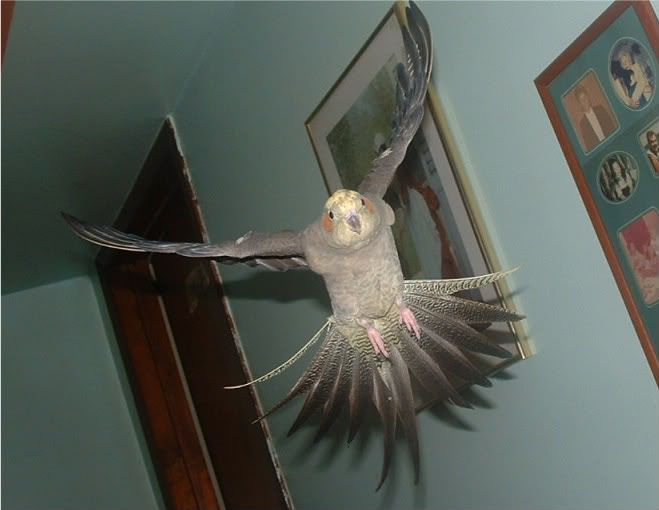Most species of parrot are monomorphic meaning that sex can’t be determined by visual means. Usually DNA testing is necessary to accurately tell if Polly is truly a she. There are a few species, however, such as the beautiful eclectus, who are notably color dimorphic. The female is red and blue, while the male is a vibrant green. But, this is not the norm in the parrot world.
The cockatiel is another species that can be visually sexed. Using a standard cockatiel as the example is this comparison, the male standard shown here (Tinky, my first born) you will notice the vibrant yellow coloring on his head and the clear definition of his orange cheek patch, Aside, from the white patches on the wings, his body coloration is a solid gray, down to and underneath his tail.

The female standard cockatiel has duller and less defined coloring on her head and perhaps the most telling sign of her sex is the barring underneath he tail:

A species that is dimorphic is the Indian ringneck, After reaching sexual maturity, the male will devolop the famous ring around the throat which they are named for. The female may have a faint, much lighter ring. It is not always an entirely accurate way of separating the sexes as birds vary within the species. Her body is stockier, her feet larger and her beak is less prominent than that of the male.

The cockatoo can be visually sexed by eye color, but it isn’t a reliable method. A typical female will have a reddish brown eye where the male’s color will be very dark brown appearing black except when exposed to light when you might see the slightest hint of brown, although I had a female umbrella with unusually dark eyes.
The male parakeet can be differentiated from the female by the color of the ceres. A male typically will have blue to purple colored ceres, while the female will generally have pink to brown.
It is important to keep in mind that, except in the case of the eclectus, none of these methods for sexing are absolute. The only certain method (with 99.9% accuracy) is DNA testing.
Photo credit: Anne Lonjak
Author Patty Jourgensen specializes in avian health, behavior and nutrition and has been working with and caring for rescue birds since 1987.



3 comments
For budgies it’s very easy to tell! For females, all color mutations, when mature, will have a white or light blue cere, or a brown kind of crusty looking cere when she is broody. Males, with the exception of a few color mutations, will have bright blue Ceres when mature. Some mutations such as the albino or lutino, will have purpley-pink colored cere. Young females usually have a more blue colored cere and will have white rings around the nostrils. For young males it is usually purpley-pink.
I talked about Indian Ringnecks at the end of the post. They can be visually sexed. Quakers can’t without DNA sexing.
What about Quaker Parrots and Indian Ringneck Parakeets? How can you visually tell what sex they are? Thank you.
Leave a comment